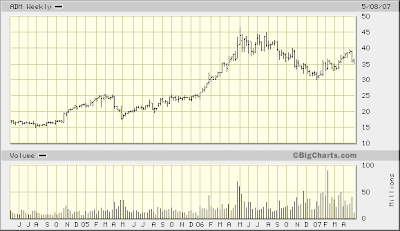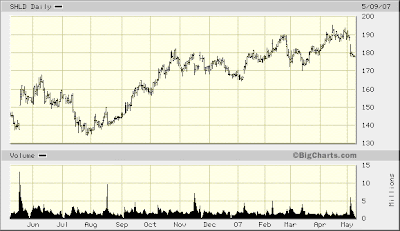
As rapidly growing businesses become larger percentage growth inevitably declines. This is the law of large numbers
Back in January and February I had two posts on Google and it’s share price. Rather than regurgitate all of them you can view them here and here. Please read them before continuing so we are all thinking the same way. Let’s update with more recent numbers.
My opinion was and is that Google shares will be stagnant of fall near term (1-2 years). This is not due to a failure of management, products or execution. It is due to the share price getting ahead of the laws of math (large numbers)
% of Income From Revenues:
Net income as a percent of revenues fell from 29% in 2006 to 27% Q1 2007. This is probably due to the YouTube acquisition and the Doubleclick one will further deteriorate this metric but we will use it as so as to not being accused of fudging numbers to make a point.
Let’s do some numbers. Consensus estimates are for 2007 earnings of $15.12 a share (48% EPS growth over 2006). So the question is, “what revenue number do we need to get there”? I am going to use 329 million shares outstanding at year end to be consistent with the share dilution the last year. This number will turn out to be too low as there will be more dilution but again, don’t want to be accused of fudging. This gives Google net earnings of $4.97 billion in 2007. This is 60% net earnings growth but the continued share dilution will prohibit this from all dropping to the bottom line. At net income of 27% of revenues, Google must produce revenues in 2007 of $18.4 billion.
I should note here that that the $18.4 billion dollars represent 80% revenue growth of $8.4 billion dollars and is almost equal to the total revenue growth of 2005 and 2006 combined. Won’t happen. It is an especially large nut to crack when you consider that 2006 revenue only grew 73% and Q1 2007 only 63%. We also need to consider that Google is coming into the slower summer months which will put real pressure on the last 3 months of the year to produce revenues equal to almost the entire first 9 months. I get this by taking the $3.6 billion from Q1 and giving Google $3 billion for Q’s 2 and 3 to reflect the anticipated seasonal slowdown. This leaves us with $9.6 billion left at the end of Q3, $9 billion short of the revenue needed for our $18.4 billion to give us $15.12 a share eps. Even if we allow for Google to turn Q’s 2 and 3 into Q1 beaters and give them $4 billion in revenues each, that still leaves them $7 billion short for the Q4. Just too much.
Other Share Price Headwinds:
Dilution:
Google used stock to purchase YouTube and as of q1 2007, basic shares outstanding have increased 2.6% to 308 million since Dec. 2006 (13% since 2005 and 60% since 2004) and the employee option program will expedite the rate of increase of this dilution.
From the Google site:
“If an employee chooses to sell options in the TSO program, he or she will use an internal online tool built by Morgan Stanley to sell them to the highest-bidding financial institution. The financial institutions buying the options will then likely hold them until maturity and then settle with Google. Google’s employee stock options typically have a ten-year term from the grant date. Under the TSO program, Google’s employee stock options, upon transfer, will have a lifespan of the lesser of two years or up to the remaining term under the original grant.”
What is very interesting here is that in January, the Google site speculated that buyers of the options would short the stock to hedge the option purchase. This now has been has been eliminated from the explanation.
Now, Google could offset this dilution by buying back huge blocks of shares but this is highly unlikely since they re using the shares as currency to make purchases. This implies that they feel a dollar of stock is currently valued at more than a dollar of currency. This is another valuation warning
Acquisitions:
A large acquisition from Google could blow EPS estimates out of the water. But, looking at past history, Google did overpay for YouTube and did the same thing for Doubleclick and neither will do anything for earnings anytime soon and YouTube will likely turn into a litigation drain on cash well before it actually makes any money. Based on history, we need to discount this possibility as acquisitions are one thing Google has not done very well at all so far.
Analysts:
I cannot find a single “hold” or “sell” rating on shares of Google. As a bit of a contrarian, when I see that I instantly get alarmed. No company is flawless and when there are no dissenting voices, people hear the same positive drumbeat repeatedly. That leads to overconfidence in the company and its shares and make the inevitable mistake harder on everyone.
Now, let’s talk multiple on the shares and prices. Last year, Google grew EPS 97% and traded at a PE multiple of roughly 2/3 that in the 60’s. Companies with declining growth rates trade at multiples that are a discount to those rates. Let’s say I am wrong on everything and they do end up hitting the $15.12 estimates. That would mean EPS growth in 2007 of 48%, down from 97%. If we apply the same 2/3 multiple we get a PE of 31 times earnings or a price of $468. It is not unreasonable to expect a multiple contraction of 50% for a growth rate reduction of a like amount especially when you consider EPS growth in 2008 will be even slower.
In January I wrote:
“You should expect the multiple for Google to contract to a range commensurate with its growth rate. If that rate this year is around 30% expect the PE to shrink to about 30 times 2007 earnings. That gives us a price for Google shares of about $450 a share.”
Google hit $450 not long after (it was $500 when I wrote it) and has bounced around the $460 to $470 range most days since then. I cannot see any reason that Google deserves to be priced at any higher than that anytime soon.
I recently had an email conversation with a hedge fund manager who will remain nameless since I did not get his permission to air our discussion and have no desire to anger anyone. In that discussion he stated “…Google is at a new pace, one of none other than Google’s…” When I hear talk like that, I instantly flash back to 1999 and 2000. “New” seldom is new, only “different” and that means the same laws of finance and math still apply. In our digital age competitors catch up more quickly and tech titans reign at #1 become shorter and shorter. This is rather ironic because it is the same digital technologies that enable their meteoric accent to begin with. IBM reigned for almost 30 years, Microsoft for about 12 and Google has been there for about 5 now. Growth slowed for all as they grew and matured and Google has proven to be no exception. It shares, however, have not realized that fact yet as they have already priced in this years earnings. Should Google stumble one quarter as all companies eventually do, look out below.
I will reiterate my closing statement from my January post. Great company, great products, it’s shares are just over priced.
I await the angry emails and comments.






